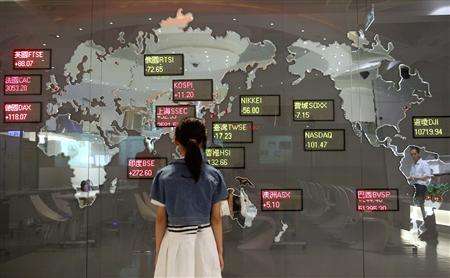 GLOBAL STOCKS GAIN; DOUBTS ARISE ON END TO FED PURCHASES
GLOBAL STOCKS GAIN; DOUBTS ARISE ON END TO FED PURCHASES
NEW YORK, Aug 23 (Reuters) – Benchmark stock indexes around the world edged higher on Friday, while the dollar fell after a U.S. government report on new single-family home sales raised doubts about the timing and extent of cuts to the Federal Reserve’s stimulus program.
New home sales dropped 13.4 percent in July to an annual rate of 394,000 units, well below expectations, the Commerce Department said, dimming what has been a bright spot in the U.S. economic comeback.
Europe’s main stock markets were steady to higher but attention remained firmly on Asia after a torrid week that has wiped billions of dollars from emerging markets for the second time in two months. EMRG/FRX
Yields on U.S. Treasuries traded lower but still near two-year highs, with investors reluctant to break out of recent ranges, given uncertainty around when the Fed might slow its massive bond-buying program. The benchmark 10-year U.S. Treasury note US10YT=RR was up 18/32, its yield at 2.818 percent.
“This has been a very unique market situation, with the Fed stimulus being such an important component to the market rally. This is uncharted waters for us,” said Gordon Charlop, managing director at Rosenblatt Securities in New York. “So regardless of what the move is, the fact you are someplace you haven’t been before is cause for uncertainty.”
The next Fed monetary policy meeting is set for Sept. 17-18.
The Dow Jones industrial average .DJI rose 46.77 points or 0.31 percent, to 15,010.51, the S&P 500 .SPX gained 6.54 points or 0.39 percent, to 1,663.50 and the Nasdaq Composite .IXIC added 19.085 points or 0.52 percent, to 3,657.792.
The biggest risk facing the U.S. economy is a premature policy tightening by the Federal Reserve, Stanford University economist Robert Hall told the Kansas City Federal Reserve Bank’s annual conference in Jackson Hole, Wyoming. (Full Story)
MSCI’s emerging share index .MSCIEF had its first gain after six sessions in the red, while selling of India’s rupee INR=D2subsided after the currency’s worst week against the dollar in decades.
“Hopefully the worst (of the emerging market selling) may now be over,” said Hans Peterson, global head of asset allocation at SEB investment management. He added that his firm may soon start “bottom fishing” in Asia.
“It doesn’t seem to be a repeat of the 1997 (Asian crisis) situation … and it seems like people are not so keen on being extremely short anymore, so it might twist around a bit.”
The dollar surrendered gains against a basket of currencies .DXY after earlier climbing to a three-week peak versus the yen, helped by the rise in U.S. bond yields on expectations the Fed will reduce its asset-buying program next month.
YIELDS BUILD
This week’s market turbulence has been driven by growing evidence that the Fed is ready to start closing the taps on its huge stimulus program, a conviction that is being bolstered by strengthening global data.
Germany confirmed on Friday that its economy grew at a 0.7 percent rate in the second quarter, while Britain revised upward its growth numbers. (Full Story) (Full Story)
Purchasing managers’ surveys this week showed better-than-expected growth in the euro zone, a Chinese manufacturing rebound and U.S. manufacturing activity at a five-month high. (Full Story)
Europe’s FTSEurofirst 300 .FTEU3, rose 0.4 percent on Friday. A rebound in Asia and Europe helped push MSCI’s global share index .MIWD00000PUS up 0.8 percent, although it was not enough to prevent it heading for its third weekly fall.
EMERGING MARKET OUTFLOWS
U.S. Treasury yields tend to set the benchmark for borrowing costs across the globe, so their recent rise – expected to continue as the Fed winds down support – is making it more difficult for indebted countries and firms to pay their bills.
Data from Boston-based fund tracker EPFR Global on Thursday showed $1.3 billion fled emerging debt funds in the week ending Aug. 21, the biggest outflow since mid-July. (Full Story)
Whereas May and June’s sharp selloff in emerging markets calmed when the change in direction of U.S. market rates made shorting (betting against) those assets unprofitable, this time that did not happen, meaning the selling could run for longer.
Brent and U.S. crude found early support from disruptions to Libyan exports. Brent crude LCOc1 traded up 1 percent to $111.01 a barrel, and U.S. crude CLc1 rose 1.3 percent to $106.43 a barrel.










Add comment